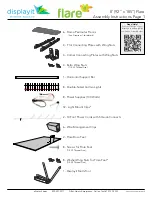
-
59
-
(b) Circuit operation theory
A basic operation theory for this interface board is to convert analog signals of Red, Green
and Blue to digital signals of Red, Green and Blue. The scaling IC has internal A/D
converter, internal OSD, built in RSDS transmitter and auto-detect input timing functions.
A/D converter is convert analog signal to digital data. OSD is offering adjustable functions to
end-user. Detect timing is for detect change mode. RSDS transmitter is used to compress
the digital RGB data, the Hsync, Vsync and pixel clock generated by Scaling then output to
LCD module. Flash-rom stores source code and MCU (embedded in Scalar) offers H/W
DDC2Bi function & controls system processing. EEPROM is stored DDC data, OSD
common data and user mode data.
(c) IC introduction:
1.) DDC (Display Data Channel) function: We use DDC IC to support DDC2Bi function. DDC
data is store in 24C02 (EEPROM). Those data related to LCD monitor specification. PC
can read them by “SDA” and “SCL” serial communication for I²C communication for
DDC2Bi.
2.) Scalar IC: There are A/D, TMDS receiver, Scaling, OSD and LVDS transmitter functions
built-in the RTD2482D IC. Scaling IC is revolutionary scaling and color engine, capable
of expanding any source resolution to a highly uniform and sharp image or down scaling
from 1920x1080, combined with the critically proven integrated 8 bit triple-ADC and
patented Rapid-lock digital clock recovery system. It also support detect mode and
DPMS control.
3.) MCU embedded in Scalar: Control unit, it controls all the functions of this interface board,
just like the OSD display setting, the adjustable items, adjusted data storage, the external
IIC communication, support DDC2Bi. .
4.) EEPROM: We use 24C16 to store all the adjustable data, user settings and uses two
24C02 to store D-SUB, DVI and HDMI data.
5.) Flash-rom stores source code.
A-2.)
Control board introduction
There are 6 keys for user's control which includes “Power”, “Menu”, “Right/Plus”, “Left/Minus”,
“Auto”, and “Enter”. The following descriptions are the introduction of these keys.
(1) Power key: to turn/off power of monitor
(2) “Menu” key: to enter sub-menus or select items.
(3) “Right/Plus key: to select previous and to increase adjustment and Brightness /Contrast
Popup submenu hotkey
(4) “Left/Minus” key: to select next and to decrease adjustment and Senseye Mode Popup
submenu hotkey
Содержание G2420HD
Страница 10: ...10 3 1 2 6 Support Timings...
Страница 51: ...51 5 4 Packing...
Страница 56: ...56 5 6 4 2 AC DC converter...
Страница 58: ...58 5 7 Circuit Operation Theory A 1 Interface board diagram A 2 Circuit operation theory a Monitor Diagram...
Страница 72: ...72 Appendix 2 Physical Dimension Front View and Side view Fig 1 Physical Dimension Front View and Side view...
Страница 73: ...73 Fig 2 Appearance Description...















































